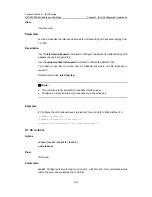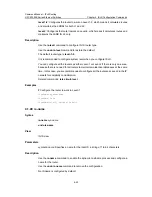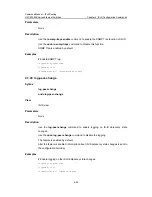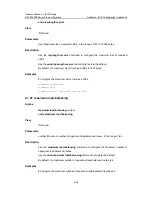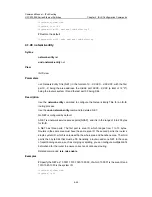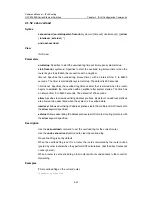
Command Manual – IPv4 Routing
H3C S7500E Series Ethernet Switches
Chapter 4 IS-IS Configuration Commands
4-52
4.1.52 set-overload
Syntax
set-overload
[
on-startup
start-from-nbr
system-id
[
timeout
[
nbr-timeout
] ] ] [
allow
{
interlevel
|
external
} * ]
undo
set-overload
View
IS-IS view
Parameters
on-startup
: Specifies to start the overload tag timeout timer upon system startup.
start-from-nbr
system-id
: Specifies to start the overload tag timeout timer when the
router begins to establish the connection with a neighbor.
timeout
: Specifies the overload tag timeout timer, with an interval from 5 to 86400
seconds. The timer is started after system startup. The default is 600 seconds.
nbr-timeout
: Specifies the overload tag timeout timer that is started when the router
begins to establish the connection with a neighbor after system startup. The time has
an interval from 5 to 86400 seconds. The default is 1200 seconds.
allow
: Specifies to allow advertising address prefixes. By default, no address prefixes
are allowed to be advertised when the system is in overload state.
interlevel
: Allows advertising IP address prefixes learnt from different IS-IS levels with
the
allow
keyword specified.
external
: Allows advertising IP address prefixes learnt from other routing protocols with
the
allow
keyword specified.
Description
Use the
set-overload
command to set the overload tag for the current router.
Use the
undo set-overload
command to clear the overload tag.
No overload flag is set by default.
When the overload flag is set for a router, the routes calculated by the router will be
ignored by other routers when they perform SPF calculations. (But the direct routes will
not be ignored.)
When a router is set overload tag, other routers will not send packets to the router for
forwarding.
Examples
# Set overload flag on the current router.
<Sysname> system-view





